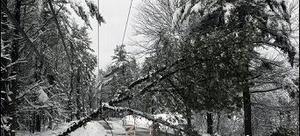Courtney Dentch
BloombergTue, 10 Apr 2007 09:35 UTC
The groundhog's prediction for an early spring is proving wrong in New York City, where a cold front has kept temperatures about 7 degrees below the historical average this month, the National Weather Service said.
Just 10 days into April, temperatures have averaged 42 degrees Fahrenheit (5.5 Celsius), about one degree warmer than the average for April 1874, the coldest on record, said Michael Silva, meteorologist with the National Weather Service's Upton, New York, station.
ATLANTA - It may be two weeks into spring, but it's beginning to look a lot like Christmas.
Cold temperatures in much of the country have those celebrating Easter this weekend swapping out frills, bonnets and sandals for coats, scarves and socks. Baseball fans are huddled in blankets, and instead of spring planting, backyard gardeners are bundling their crops.

|
| ©AP Photo/Pat Wellenbach
|
| A tree lies on top of downed power lines in Brunswick, Maine, Thursday, April 5, 2007. ...
|
CONCORD, N.H. - Utility crews worked to restore power Friday to tens of thousands of northern New Englanders after a spring snowfall dumped more than a foot of snow around the region.
Schools in Fergus Falls and Browns Valley are closed and more than a dozen western Minnesota school districts are starting classes two hours late this morning as winter returns to the state.
Winter storm warnings are out for the central third of Minnesota, and snow advisories are out for areas north and south of that band.
STOCKHOLM- Sweden said Wednesday it would give its reindeer herders millions of euros (dollars) in emergency aid to help them feed their animals, which are starving because of thick ice that is preventing them from reaching the lichen they eat.
"You can't just stand by and watch animals starve," Agriculture Minister Eskil Erlandsson said in a statement as his ministry earmarked 37 million kronor (4.06 million euros, 5.3 million dollars) in aid.
There's a dimmer switch inside the sun that causes its brightness to rise and fall on timescales of around 100,000 years - exactly the same period as between ice ages on Earth. So says a physicist who has created a computer model of our star's core.
Robert Ehrlich of George Mason University in Fairfax, Virginia, modelled the effect of temperature fluctuations in the sun's interior. According to the standard view, the temperature of the sun's core is held constant by the opposing pressures of gravity and nuclear fusion. However, Ehrlich believed that slight variations should be possible.
How many of you have seen the movie "The Day After Tomorrow?" If you haven't, the thesis of the movie is that Global warming causes large areas of the Arctic to melt, so that the northern Atlantic ocean is diluted by large amounts of fresh water which changes the density of the water layers causing a disruption of the Thermohaline current.. This then leads to a rapid and unnatural cooling of the northern hemisphere which triggers a series of anomalies, eventually leading to a massive "global superstorm" system consisting of three gigantic hurricane-like superstorms, which suck up heat and drop the super-cold upper atmospheric air down onto the planet resulting in an "instant Ice age."
IS EUROPE'S central-heating system about to break down, causing climate chaos around the world? Late last year, oceanographers reported a sudden and shocking slowdown in the currents of the North Atlantic, a critical part of the vast system of ocean circulation that influences temperatures and weather around the world. A shutdown could cause famine in south Asia, kill off the Amazon rainforest and plunge western Europe into a mini ice age.
Some people are naturally graceful on the dance floor, while others seem burdened by two inept left feet. Blame it on the Ice Age.
According to new research, the ability to dance may have been a factor in survival for our prehistoric ancestors, who used their moves to bond and communicate with each other when times were tough.
A study published in a recent issue of the Public Library of Science's genetics journal, suggests that, as a result, today's creative dancers actually share two specific genes. Both genes are associated with a predisposition for being good social communicators.
ST. PETERSBURG, Russia - A Russian astronomer has predicted that Earth will experience a "mini Ice Age" in the middle of this century, caused by low solar activity.